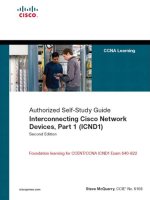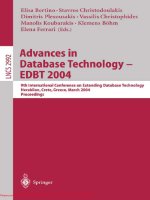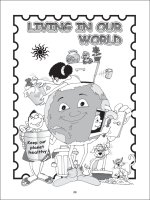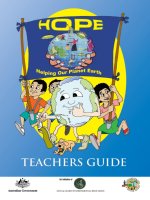Tài liệu Helping Our Planet Earth P1 ppt
Bạn đang xem bản rút gọn của tài liệu. Xem và tải ngay bản đầy đủ của tài liệu tại đây (2.72 MB, 30 trang )
Acknowledgement
Thank you to all who have joined and supported the HOPE network since 2003, and contributed
to the development of the HOPE Programme:
o Australian High Commission (Direct Aid Program) for supporting the development &
production of the HOPE- ESD Teachers Guide;
o British High Commission; European Commission; Vodafone ATH Fiji Foundation; British
Petroleum South Pacific; SOPAC;
o Ministry of Education- Curriculum Development Unit & District Education Officers; particularly
Mrs. Viniana Kunabuli, Mrs. Kelera Taloga & Mrs. Prabha Nair (CDU);
o Schools, teachers & students in Suva, Nausori, Navua, Lautoka, Labasa, Savusavu and
Rakiraki particularly HOPE network coordinators and members;
o Lecturers from the Fiji College of Advanced Education: Mrs. Fesi Filipe (Social Science); Mrs.
Mere Daveta (English); Mr. Matereti Sarasau (Science); Mr. Qiokata (Maths);
o Partners & friends of Live & Learn Environmental Education; including Department of
Environment & The National Trust of Fiji.
o All Live & Learn staff members involved in developing, adapting and trialing the activities;
o John Robinson (cartoonist).
o Proof Readers - Leonie Smiley (FSPI), Alex Ralulu and Dorris Ravai (LLEE).
o Editors - Iva Bakaniceva and Marie Fatiaki (LLEE).
We would also like to acknowledge the following sources of references, from which we have gathered
some activities, adapted and further developed to suit the local curriculum and HOPE context:
o Drama in Environmental Education- A Guide; Wan Smol Bag Theatre Publication; J. Dorras &
H. Corrigan; 2002.
o Education for Sustainable Development Toolkit; R. Mckeown; C.Hopkins; R.Rizzi & M. Chrystalbridge;
Energy, Environment & Resources Centre; University of Tennessee; 2002.
o Sharing Nature with Children II- A Sequel to the Classic Parents’ & Teachers’ Nature Awareness
Guidebook; J. Cornell; Dawn Publications; 1989
o Skills for Democracy- Promoting Dialogue in Schools; S.Preskill; L. Vermilya & G.Otero; Hawker
Brownlow Education; 2000.
o Teaching Green- The Middle Years- Hands-on Learning in Grades 6-8; edited by T. Grant &
G. Littlejohn; New Society Publishers; 2004
o The Global Classroom- Activities to engage students in third millennium schools; T. Townsend &
G.Otero; Hawker Brownlow Education; 1999.
o Youth Topics- The Ultimate Collection; CAFOD; Christian Aid; SCIAF
o Thank you Project WET (Water Education for Teachers) International Foundation for permission to
use the activities: The Incredible Journey (pp 161-165); A Drop In The Bucket (pp 238-241) ; Aqua
Bodies (pp 63-65); Flush Bowl (Super Bowl Surge pp 353-359); and Sum of The Parts (pp 267-270);
as published in the Project WET Curriculum and Activity Guide; copyright 1995 by the Project WET
International Foundation. Used with permission.
Copyright: Live & Learn Environmental Education 2006
The HOPE Teachers Guide is not for sale!
1
Teachers Guide HOPE - HELPING OUR PLANET EARTH
Content
1. Welcome ....................................................................... 3
2. The HOPE Teachers Guide .......................................... 4
3. HOPE In Action ............................................................ 5
4. Looking at Sustainability ............................................ 9
5. Living in Our World .................................................... 29
6. A Glimpse of Nature ................................................... 48
7. Waste Not, Want Not ................................................. 69
8. Water for Life .............................................................. 86
9. Fiji Fast Facts! ............................................................ 108
2
Teachers Guide HOPE - HELPING OUR PLANET EARTH
Welcome
Welcome to the first edition of the HOPE
(Helping Our Planet Earth) Teachers Guide.
This guide has practical classroom activities for
teachers to help promote student awareness on
environmental and development issues!
The purpose of the HOPE Teachers Guide is to
provide teachers with classroom resources to
address education for sustainability for the
students of Fiji, that is linked to existing
curriculum.
It is hoped that through these activities, students
will gain more skills to become active and
equipped citizens in their communities.
These activities have been trialed with teachers
and students in Suva, Nausori, Navua, Lautoka,
Labasa, Savusavu, and Rakiraki.
The activities are designed to strengthen school
existing curriculum themes; give students an
opportunity to share ideas; views; and generate
solutions for issues that concern them.
To share the experiences of HOPE schools and
promote HOPE, a HOPE Teachers Guide and
HOPE Video was developed.
Good luck teachers with the use of the HOPE
Teachers Guide and thank you!
The Decade of Education for
Sustainable Development
In December 2002 the United Nations General
Assembly declared 2005 – 2014 the UN Decade
of Education for Sustainable Development
(DESD).
Education for Sustainable Development
“is a process for learning how to make
decisions that consider the long-term future of
the economy, ecology and equity of all
communities. Building the capacity for futures-
oriented thinking is a key task of education”.
The basic vision of the DESD is a world where
everyone has the opportunity to benefit from
education and learn the values, behavior and
lifestyles required for a more sustainable
future.
Students are seen as future leaders and also an
effective medium for bringing sustainable
development into every nation. Therefore they
need to expand their knowledge and civic skills
like critical thinking, building dialogue, problem
solving, decision making and active
participation to be able to bring about the
changes foreseen by the leaders of today.
Teachers play a vital role in trying to achieve
sustainable development with their role as an
educator both inside and outside the
classroom. They are the ones that will broaden
their student’s knowledge about environmental
and social issues. In the classroom, concerns
addressed and skills taught, will help these
young people to be sustainable resource users
in the future.
3
An Initiative of
Teachers Guide HOPE - HELPING OUR PLANET EARTH
The HOPE Teachers Guide!
The activities in the HOPE manual take issues, values and knowledge to higher levels of
understanding so students can link inter-relationships and complex issues relating to the
environment and development. These issues are broad in focus and are based on social,
environmental and economic themes.
The activities are designed to enable students to develop skills such as:
o communication;
o critical thinking;
o exchanging ideas;
o social development;
o creative capability;
o environmental citizenship;
o valuing nature; and
o dialogue and decision making.
Teachers can adapt these activities for use in different class levels and subject areas (Mathematics,
English, Elementary Science etc).
Each activity is accompanied with ‘deconstruction questions’. These are questions that are
asked during or at the end of activities to promote critical thinking and a deeper understanding of
what is learnt.
Teachers are encouraged to add on to the deconstruction questions, and chop and change where
necessary depending on the topic or concepts to be learnt.
Deconstruction is like peeling away the layers of an onion-
you get to see what is below each layer. In the same way,
you examine the issue or concept to be studied in many
different ways. By doing this, students get to reason,
think critically and understand different points of view.
The development of critical thinking skills helps to ask
questions about the information we receive and analyse
it rather than accept it all at face value.
Exchanging dialogue in the classroom can produce good
student critical thinkers. Good critical thinkers have the skills
of being able to weigh different sources of information, take into
account all points of view and judge the value of new knowledge.
In this way students develop a sharp and very open mind.
4
Teachers Guide HOPE - HELPING OUR PLANET EARTH
Example of ‘whole school- HOPE efforts’ 2003-2005
· School HOPE areas were decided by students and each Form or House was given a different
area of the grounds to plan environmental activities for.
· Each student provided a plant cutting from their home garden and was responsible for looking
after it in the school grounds.
· All schools made a green house for raising seedlings/propagating plants.
· Many started recycling projects, recycled wood for birdhouses, seating, green houses, recycled
paper for art class, bottles for garden edging etc.
· Many schools constructed and started using composts.
· Some schools did environmental audits to reduce energy consumption.
· Reduce the amount of packaging sold at the school canteen, less plastics, less non-recyclables.
· Many schools got in touch with local plastic bottle recycling plants and started a collection
scheme.
· Actions were decided by students and each form or house was given a different area of the
grounds to plan environmental activities for.
· Many schools cleaned up and sorted wastes in incinerator areas.
· Some schools obtained community participation and in kind support in improving school
aesthetics.
· Some non-gardening schools started growing vegetables to share with students and sell at
community markets to raise money for future environmental works.
· Some schools designed different coloured bins in classrooms for different kinds of waste.
· Some students created a sensory garden with different feeling and smelling plants for younger
students to explore.
· Several schools created a pleasant outdoor classroom learning area in the shade with recycled
wood.
· Many schools labeled plants with their common name, and pointed out their uses (everyday,
medicinal etc), in the grounds.
· Many students painted environmental messages on school walls and fences.
· Herbal medicine gardens with cuttings from community gardens and information from the
community used in the garden for learning traditional cultural medicines.
· Many students kept HOPE diaries, wrote environmental poetry, designed posters, made models
and did HOPE activities in class as well as outside.
· Teachers conducted participatory and exploratory sessions about the environment within
the curriculum. They were able to explore development issues with their students to enable
their students to learn some additional civic skills.
6
Teachers Guide HOPE - HELPING OUR PLANET EARTH
HOPE checklist of ideas!
Listed below are a few ideas of what the students and teachers can do in their various schools.
Ideally the teacher will facilitate planning sessions with students and think about (perhaps vision)
what they would like to do to Help Our Planet Earth. It is important that all students
participate in the suggesting, planning, designing and implementing. Everything on the list
below does not need to be done! The list is to stimulate thinking among teachers and students.
Students’ may come up with many different and more interesting ideas!
Schools should try to use recycled and reused items in HOPE actions – a budget is not required to
take part in HOPE! For example, plant cuttings can be sought from home and community gardens,
and things like leftover paint or old bits of wood and tyres may be found at the school, through
donation or in other community places. Be innovative- you don’t need a budget.
Energy Conservation
o In class, teach students about the different types of energy used in Fiji and brainstorm
and research some advantages and disadvantages. From these projects, ask students to
come up with ideas for saving energy or better strategies to use at school.
o In Math’s class, compare energy usage and cost before and after starting HOPE energy
saving initiatives.
o Put reminder notes under lights eg:”turn off lights when you leave the room.”
o Nominate student light monitors.
Water Conservation
o During class carry out a water audit to identify problem areas and take action eg: fix-
leaking taps.
o Install friendly positive action signs around schools near taps to remind students about
water conservation e.g. ‘save tomorrow’s water today’ or ‘HOPE & Save Water’ these could
be designed and made in art and craft.
o Re-use run-off/hand washing water in the garden.
o Class activity - Carry out a water audit to identify the problems and brainstorm solutions.
Waste Disposal
o Set up paper recycling boxes and arrange for Waste recyclers to collect them.
o Re-use paper that is only written on one side – establish recycled paper boxes in
classrooms and school offices.
o Clean up and sort wastes in incinerator areas, reduce burning of plastics and paper, the
fumes cause bad health and air pollution. Grass and plant cuttings should
not be burnt but
go to compost.
o Use organic paper and paper that can’t be re-used cut up very small in composts.
o Get in touch with local plastic bottle recycling plant Coca Cola and start a collection
scheme using a big collection bag.
o Plastic bottles can also be reused by painting them and sticking them upside down to make
a colorful garden boundary; they can also make a seedling container if you cut them in half
and fill them with soil.
o Encourage a class to do a litter or rubbish audit after lunchtime. Get them to make a map
of where most litter is left by students and consider putting bins in those places. This
activity could be used in Mathematics to work out percentages or make graphs of litter.
o Design or color different bins for different kinds of waste.
7
Teachers Guide HOPE - HELPING OUR PLANET EARTH
Gardens & Grounds
o Give each form or house group a different area of the grounds to look after. Students
might like to make an environmental map of the school grounds and get other students to
help design plans for the future. Planning is a very important skill for students.
o Each student can provide a plant cutting from their home garden and be responsible for
looking after it in the school grounds. Plant cuttings can be grown in recycled milk
containers cut in half.
o Build a green house out of recycled wood for raising seedlings/propagating plants.
o Start growing vegetables to share with students and sell to the community to fund
further HOPE activities.
o Plant flowers and vegetable in the same garden so it looks good and you gain produce to
eat.
o Make the grounds somewhere where students feel happy and relaxed.
o Students to use recycled wood to make as benches under shade for students.
o Encourage community participation in making the school a better place to live in.
o Encourage native animals and birds to the grounds with nesting boxes made by students
and hidden in trees
o Label plants in the grounds with their common name, and point out their uses (everyday,
medicinal etc).
o Bring in cuttings of herbal or medicinal plants garden and encourage students to find out
about their properties from their parents and grandparents. Have students share what
they have learnt about traditional medicines.
o Design a weather station with information about weather terms.
o Design a welcome sign to the school.
o Encourage propagation of trees to plant later in the school grounds.
o Students may like to paint bright happy environmental murals with messages on boring
brick walls.
Classrooms
o Have one bin in the class for food scraps, one for paper to recycle and one for plastics.
Food scraps should go into compost, paper to be reused perhaps for painting by
kindergarten, and plastics bottles recycled.
o Student projects / environmentally themed lessons – Art and craft:- Designing
environmental posters with important environmental messages. English: writing poems
about a favorite natural place, Math’s: measuring the plants outside to the nearest
centimeter, making graph of plants growth over a period of time etc. Have students design
some short plays or drama with environmental messages to perform in front of other
classes.
o Have a HOPE notice board in the school or classrooms to display HOPE NOTES (A
fortnightly newsletter that will be sent during the competition to teachers and students)
to all in the school.
o Make an ‘environment corner’ in the classroom.
o Invite some guest speakers to teach students about how to make and look after compost
or talk about how the environment of the local area has changed over time.
o Think about energy reduction (class student monitors to switch off lights and fans when
rooms are not in use).
Canteen and Lunches from Home
o Reduce the amount of packaging sold at the school canteen, less plastics and non-
recyclables. Serve small food items on newsprint rather than plastic.
o Make students aware of bringing environmentally friendly lunches from home with less
packaging and healthy contents.
8
Teachers Guide HOPE - HELPING OUR PLANET EARTH









